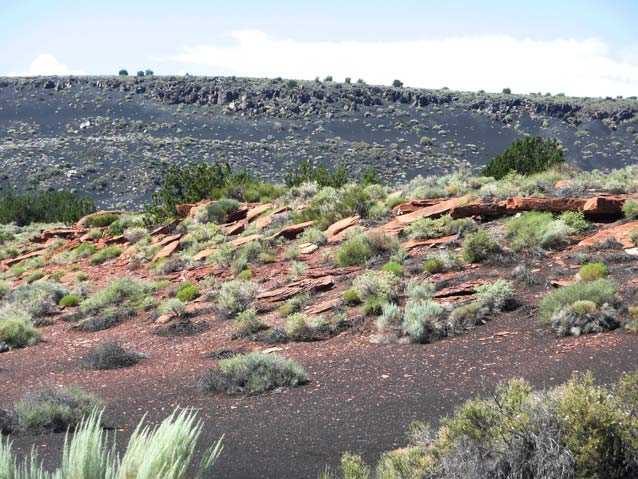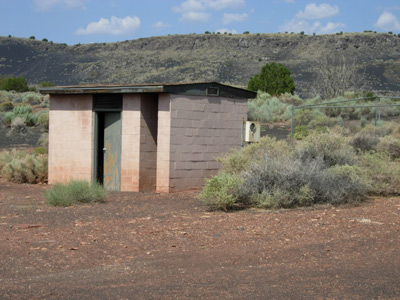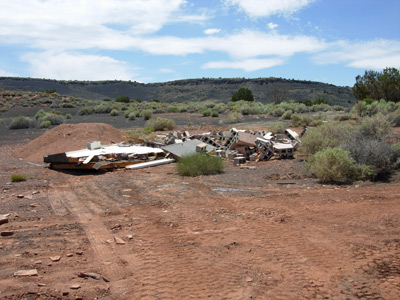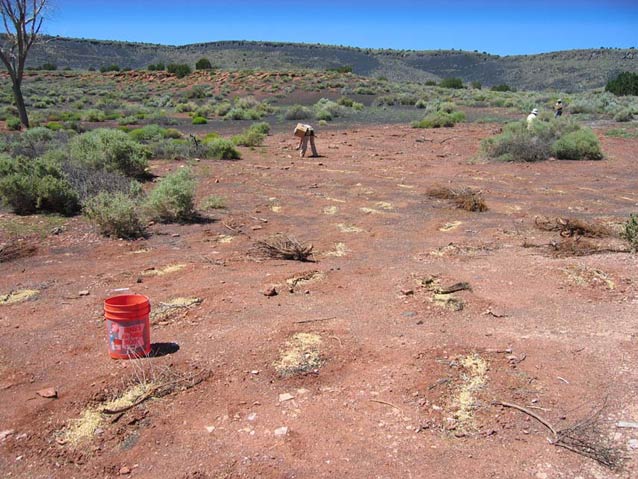Media Included
- Heiser Spring Restoration - Paul Whitefield, natural resource specialist, describes the history and restoration of Heiser Spring at Wupatki National Monument. Recorded in August 2010 and August 2011.
Wupatki, Heiser, and Peshlaki springs were historically the sole sources of perennial water where Wupatki National Monument now stands.

J. Palumbo / NPS
Evidence of human use in the Wupatki NM (WUPA) area dates back to the 1100s A.D., when ancestral Puebloan people settled the area. Later, Navajo sheepherders and Anglo ranchers used the springs to water their stock. When WUPA was established in 1924, the National Park Service (NPS) developed Wupatki Spring to supply water for the visitor center and employee housing. Flow from the spring declined steadily through the 40s and 50s, and ceased in 1959.
Peshlaki (Navajo word for “cottonwood”) Spring continued to be used by Navajo sheepherders. Because little human activity occurred here, Peshlaki Spring remained among the few reliable sources of surface water for wildlife within the monument over the last 130 years.
Heiser Spring was named for a ranch family who homesteaded at the spring from 1912 until 1915. During the Great Depression in the 1930’s, the spring was developed to supply water for a Civilian Conservation Corps labor camp. After the NPS purchased the Heiser Homestead tract in 1950, the spring was further developed as a water supply for a nearby NPS maintenance shop and cluster of employee housing trailers.
During the 1980s, the NPS phased out operations near Heiser Spring and removed most of the structures. The 2002 General Management Plan for WUPA proposed that native riparian vegetation and surface water be restored at Heiser Spring for wildlife. After analysis however, it was determined that the water table had dropped so low in the area of the spring, it was doubtful that any water would seep or flow at the surface. The park still decided to remove all remaining water diversion structures and attempt to establish a small area of riparian vegetation to enhance wildlife habitat in the area.
Project Objectives
The objectives for the restoration of Heiser Spring were to:
- Restore the abandoned NPS housing/maintenance operations area around Heiser Spring to a landscape condition that is consistent with the purpose and significance of Wupatki National Monument.
- Restore the surrounding landscape to a more natural, prehistoric scene, while protecting archeological resources, maintaining the integrity of significant historic resources, and respecting affiliated tribal values.
- Attempt to establish a small area of riparian vegetation to enhance wildlife habitat in the area.
- Plan for the possibility that the water table may eventually rise and surface water may eventually re-occur for wildlife.
Project Implementation
The following are the main planning, information gathering, and site restoration activities that were conducted at the Heiser Spring site during fiscal years 2007 through 2010.
Year 1: FY 2007
- Northern access road was abandoned. The 1/3 mile long northern access road to the spring and the former employee housing area was barricaded and partially rehabilitated by removing most of the imported base material and lightly de-compacting the roadbed.
Year 2: FY 2008
- Project area site plan and contour map were created. The project area was surveyed and a site plan and contour map created.
- Seep and spring flora were surveyed. Local springs, seeps and riparian areas of similar elevation, range, hydrology, and geology were surveyed to (1) identify reference conditions for revegetation planning, and (2) identify plant species suitable for planting in the spring site.
- Seed was collected. American Conservation Experience (ACE) youth corps crews hand harvested seed from around the project site. About 15 pounds of seed were collected from native grasses, shrubs and forbs.
- Invasive plants were treated. The Petrified Forest NP Exotic Plant Management Team applied herbicide treatments to invasive camelthorn (Alhagi pseudalhagi ) patches within the project area.
- Revegetation methods were refined. Because it would not be feasible to irrigate the site to germinate and establish seedlings, the WUPA natural resource staff refined the revegetation methods for upland environments to include different combinations of methods used in desert ecosystems under natural precipitation patterns.
- Groundwater was monitored. Groundwater measurements were taken each month using a network of shallow wells.
- Vegetation was monitored. Natural resource staff established a set of repeat photopoints to provide qualitative information about the rate of native vegetation recovery. Access road was partially restored. An ACE crew removed dead landscape trees, cut them into pieces and used the wood for brushing treatments on the abandoned access road.
Year 3: FY 2009
- Native plants were propogated. Field cuttings of Rhus trilobata (fragrant sumac), Forestiera pubescens (desert olive), and Populus fremontii (Freemont cottonwood) were collected from the area around the spring and taken to the Arboretum at Flagstaff where they were rooted, put in planting tubes and maintained until they were ready to be planted at the spring site.

J. Palumbo / NPS
- Remaining structures were demolished and debris removed. The remaining NPS structures at Heiser Spring, including the springbox, chlorination chamber, cistern, and water pump shed, were demolished and the debris removed from the site. The lower portions of both the springbox and chlorination chamber were documented with photographs, and then abandoned in place in order to minimize possible damage to the water-bearing sandstone unit in which they were built. Native soil was used to backfill.

J. Palumbo / NPS
- Groundwater monitoring was continued. New piezometers were installed in the springbox and the chlorination chambers before backfilling during the demolition work.
- Septic system was abandoned. A septic tank and leach field were discovered buried in Heiser Wash. The remaining effluent was pumped, and ACE crew workers filled the tank with clean sand according to Arizona Department of Environmental Quality standards.

J. Palumbo / NPS
Year 4: FY 2010
- Revegetation of the site was initiated. Restoration treatments for abandoned road were completed.
- Rooted field cuttings were planted with PVC plastic deep watering tubes, and wire cages were staked around each plant to protect it from browsing wildlife.
- Shallow contours were manually furrowed into the most disturbed and compacted soils.
- The native grass and shrub seed that had been collected in 2008 was broadcast into the furrows and in high priority areas around the spring and along the abandoned access road.
- Organic litter was collected from the surrounding area and redistributed into the seeded furrows.
- Cut tree limbs from other projects in the park were hauled in to complete wood brushing treatments.
- Site cleanup was completed.
- Groundwater monitoring was continued.
Restoration Photo Gallery
Map of Heiser Spring Restoration Actions
Old Heiser Spring Restoration Actions Map, 2007-2010. Click on any of the shaded sections or balloons within the project area to view a photo and description of a restoration action taken at Heiser Spring.
Future Actions
Site recovery, monitoring, and maintenance activities were continued at the Heiser Spring area over the subsequent years. These activities included
- Hand watering the transplanted shrubs until established
- Follow-up treatments to eradicate camelthorn
- Transplant trials from the source population at Peshlaki Spring, pending the results of the common reed genetic analysis. This will increase the overall plant diversity at Heiser Spring, as well as establish a second population of this potential species of management concern at WUPA.
- Harvesting of seed and reseeding uplands, as opportunities to utilize cooperators and volunteers groups arise.
- Possible hand-tool work to control localized erosion or restore natural drainage patterns
- Water table monitoring
- Eventual abandonment of the remaining eastern access road when motorized vehicle access is no longer needed (in the meantime a cable gate has been installed to control access)
Contact
For more information, contact Paul Whitefield at e-mail us.
Prepared by Jean Palumbo, Southern Colorado Plateau Inventory and Monitoring Program, 2013.
Last updated: October 15, 2018
